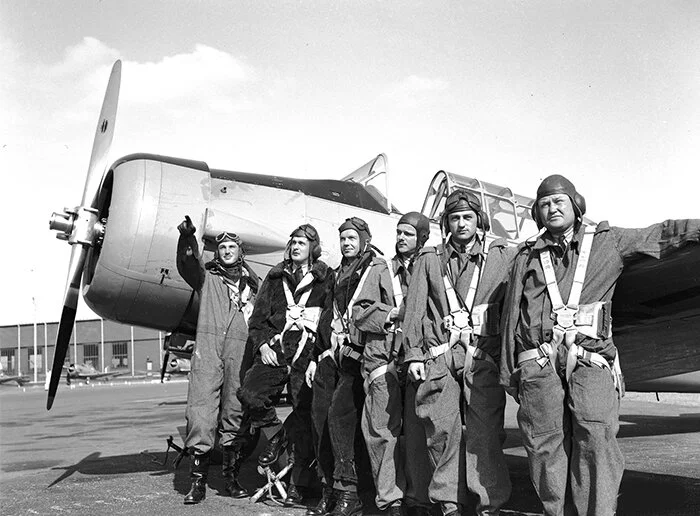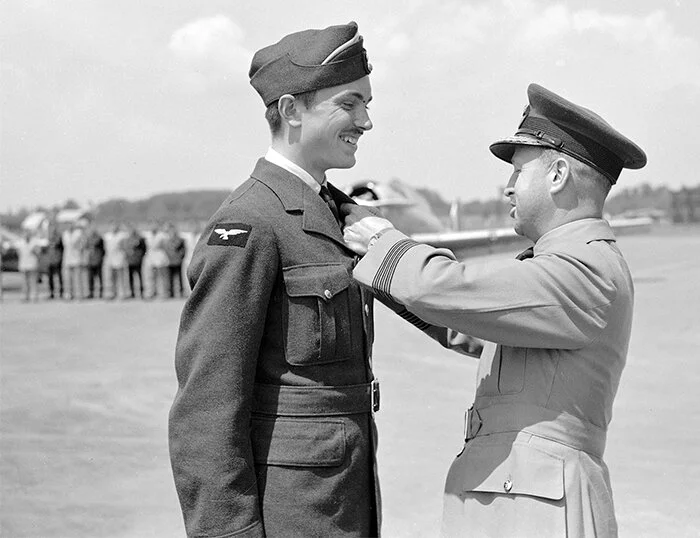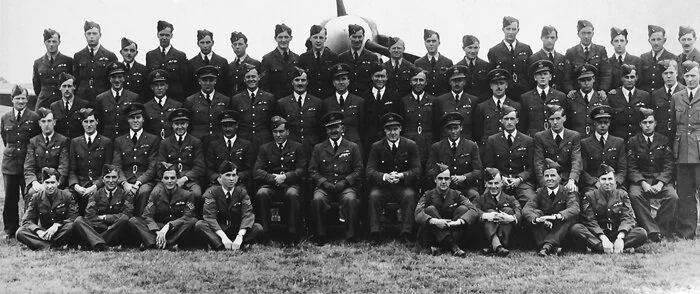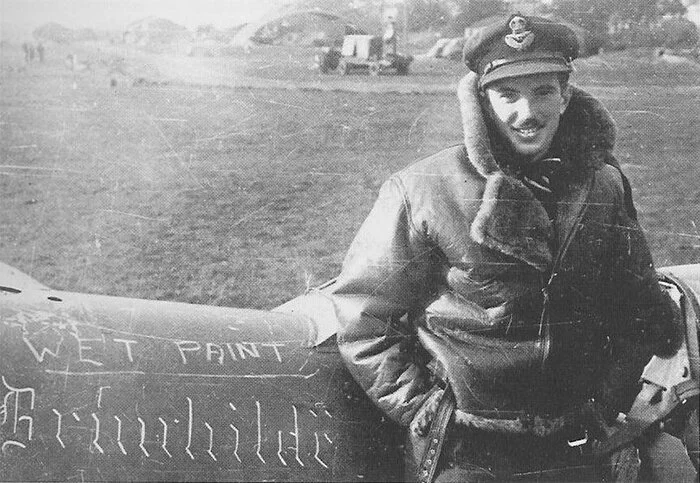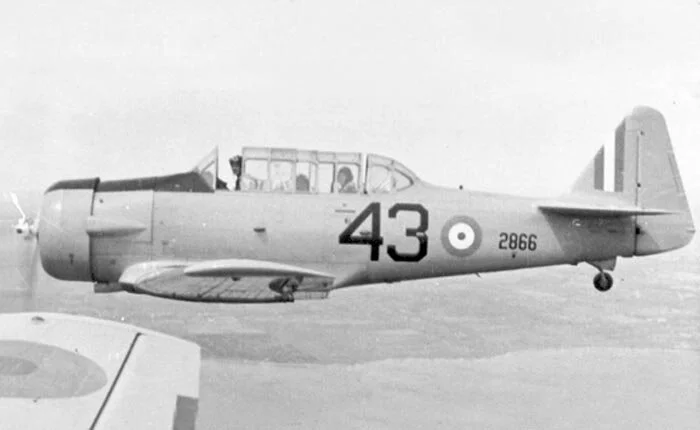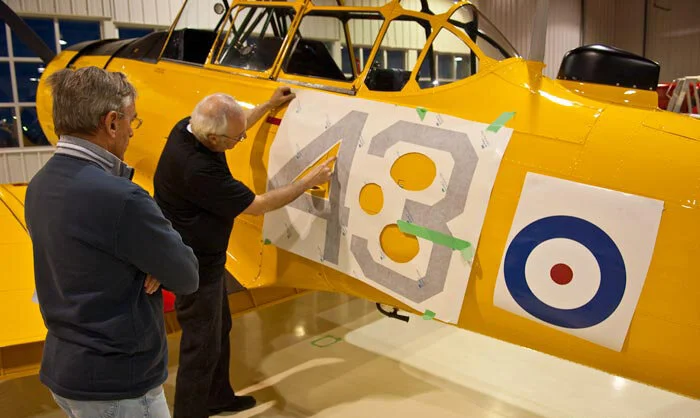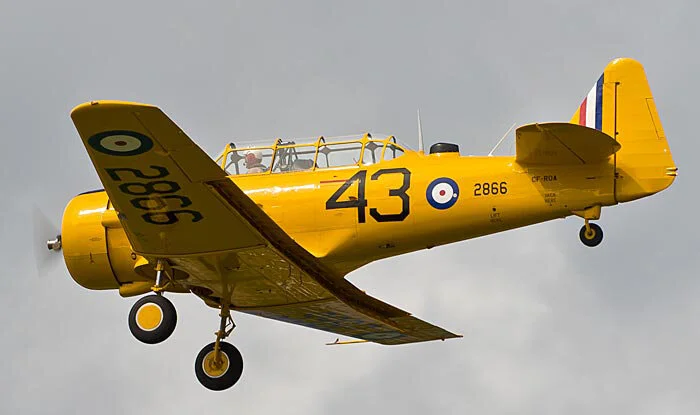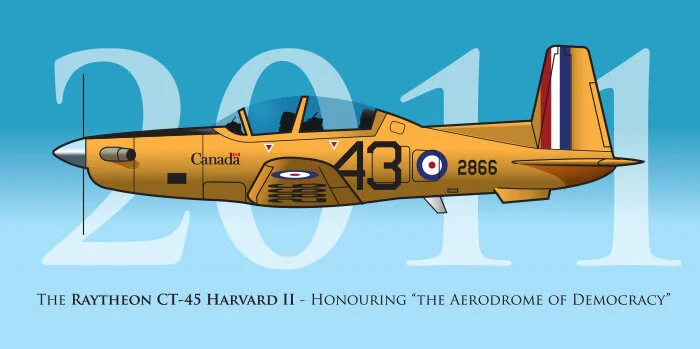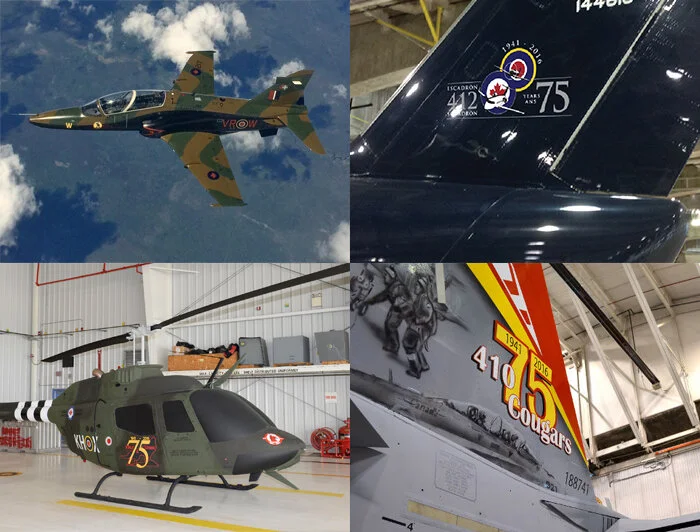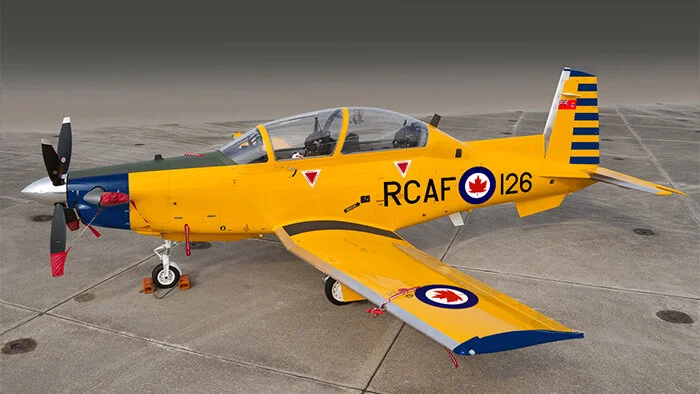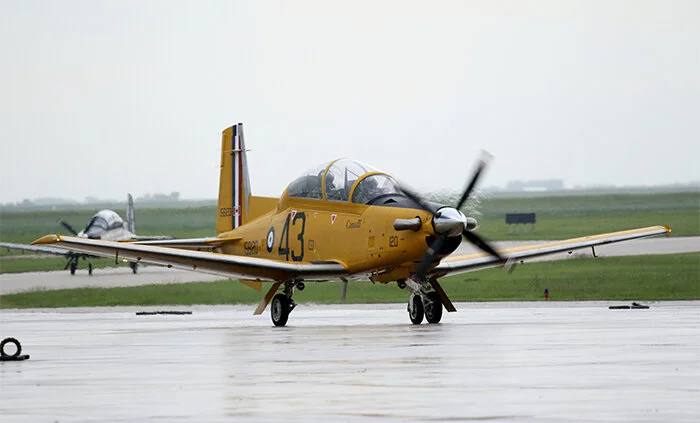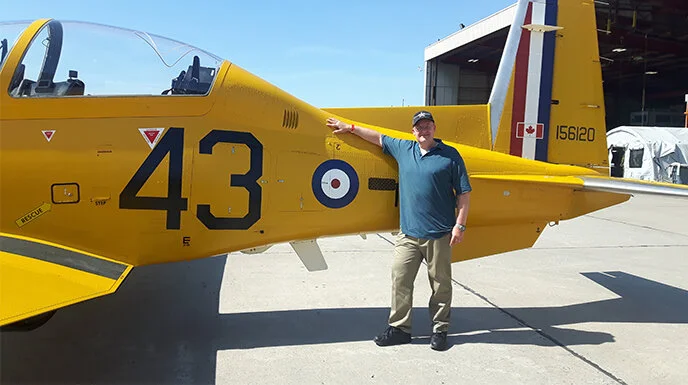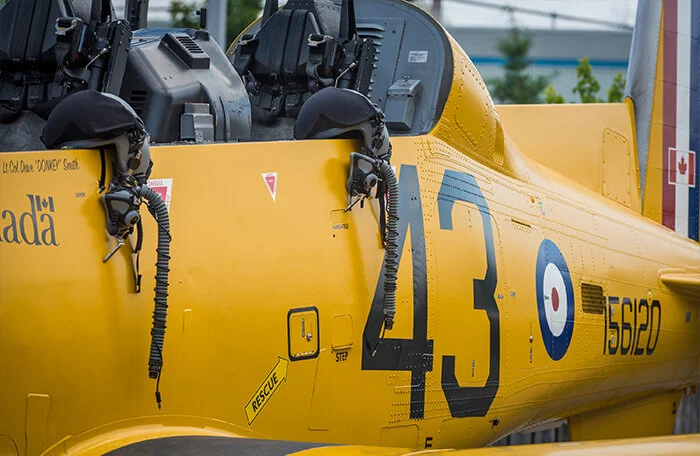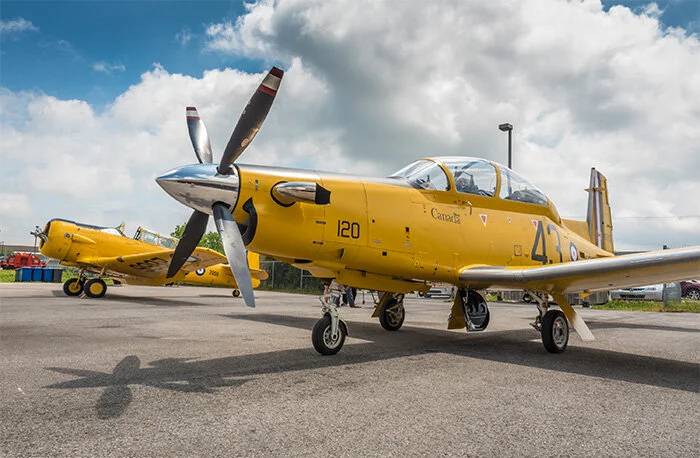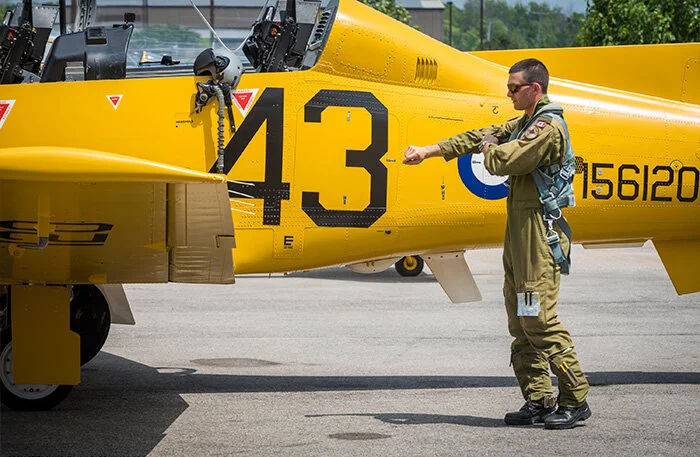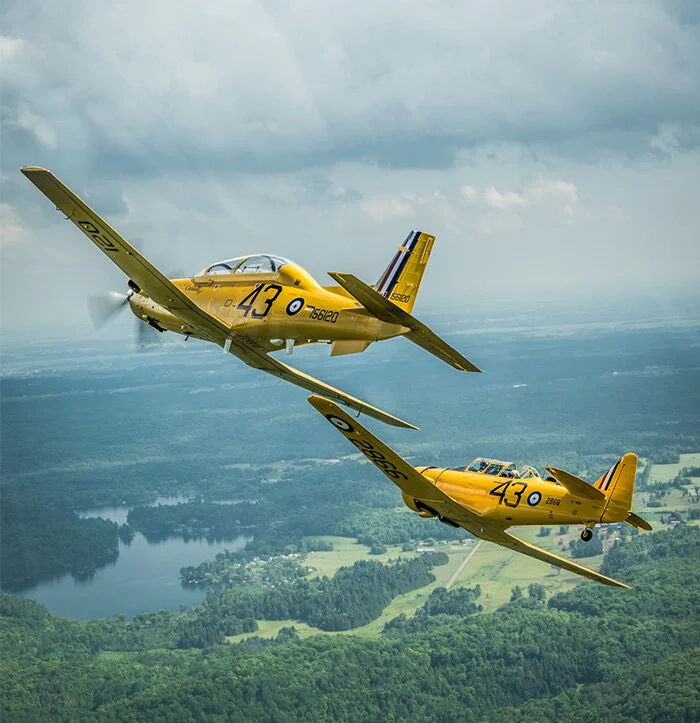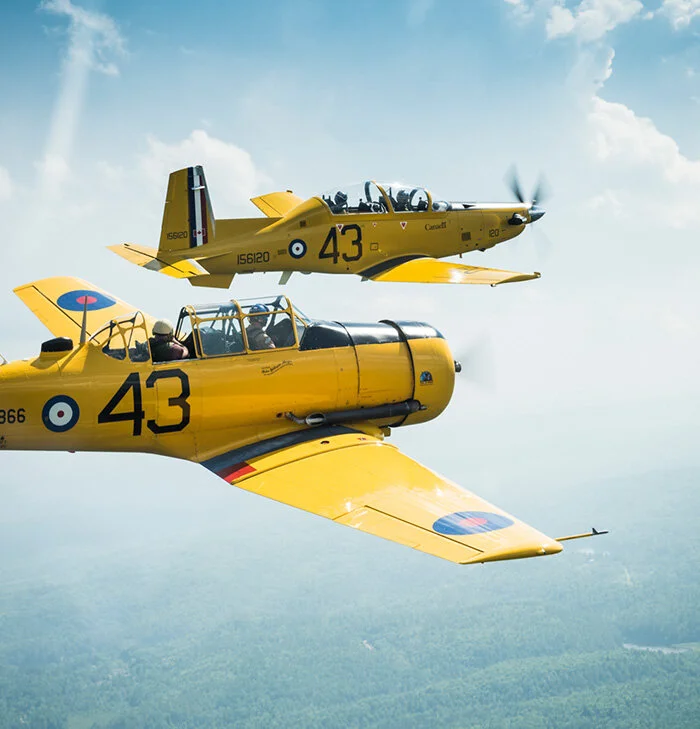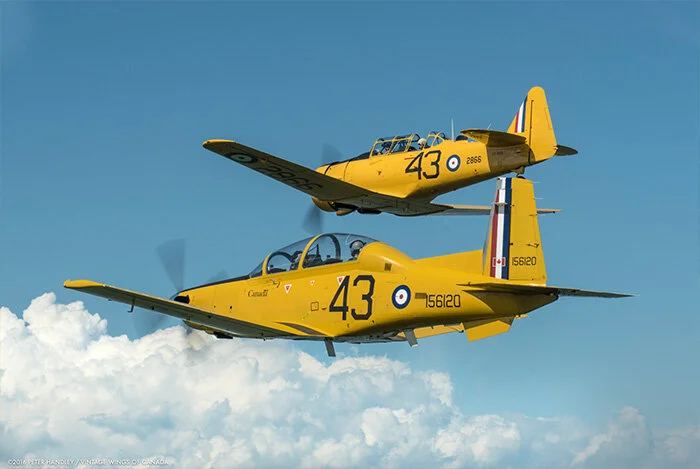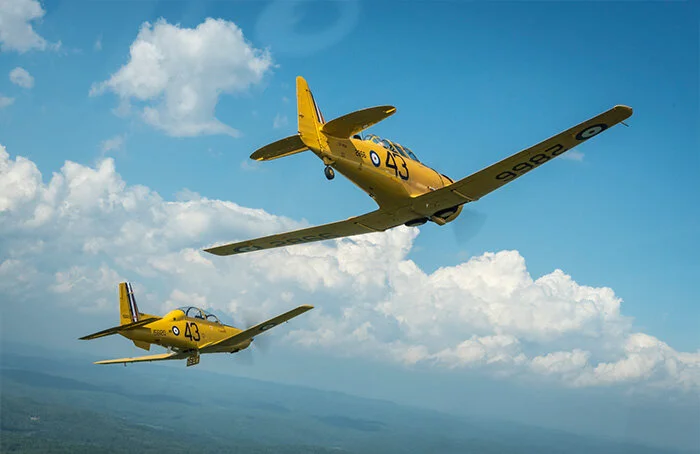The High Flight Harvards
The Royal Canadian Air Force and Vintage Wings of Canada honour the British Commonwealth Air Training Plan and one of its most beloved graduates – poet John Gillespie Magee.
On 18 August 1941, in the heat of an English summer day, teenage fighter pilot John Gillespie Magee of the Royal Canadian Air Force’s 412 “Falcon” Squadron strapped himself into a Spitfire Mk I at No. 53 Operational Training Unit at RAF Llandow. After going through his checklist, he fired up the Rolls-Royce Merlin engine and waited for it to settle into a steady rhythm. The Spit, RAF Serial R6976, was a Battle of Britain survivor from 610 Squadron and though war weary, was well maintained and running smoothly. Today, it would be his seventh flight in a Spitfire and he was gaining confidence. When he was ready, he trundled to the edge of the airfield, turned into the wind and moments later moved the throttle forward to full power. The Spitfire thundered to life, bouncing on the dry grass, tail coming up, rushing headlong, lifting easily… into history.
On that day, Magee circled and climbed through canyons of clouds, topping out at 33,000 feet on a warm sunlit day. We do not know exactly what he did on this solo training flight, but it is very likely that he simply had a lot of fun horsing the beautiful aircraft through aerobatics, carving turns through clouds, delighting in three dimensional freedom and getting to know the Spitfire, the already iconic aircraft that would soon carry him to battle. It must have been a glorious thing for a teenager to do. He stayed up for a full two hours.
When he landed, he recorded the flight without any embellishment in his logbook, but it clearly had a profound impact on the young American. In the next few hours, he penned what many consider the greatest poem to come out of the Second World War and certainly the most enduring verse about the unbridled joy and glory of flight. The poem, which Magee entitled “High Flight”, is known by every English-speaking pilot on the planet—carried in their wallets, pinned to their walls, tattooed on their bodies, read at their funerals, carved on their headstones.
Four months later, Magee would be killed when his Spitfire, descending through a hole in the clouds collided with an Avro Anson flying beneath the cloud. Both pilots were on a training flight. Both were killed. It was a sad end to a very short life for Magee, who was born in Shanghai, China to a British mother and American missionary father. Magee was later educated at England’s famous Rugby School in Warwickshire where he had exhibited a nascent talent as a poet. He had joined the Royal Canadian Air Force from the United States in 1940, declining scholarship to Yale University.
A posed photograph of American student pilots of the British Commonwealth Air Training Plan at No. 2 SFTS Uplands, Course 25 in the spring of 1941. This was in the weeks leading up to the filming at Uplands of major sequences of Captains of the Clouds, Warner Bros.’ largest production to date. Starring James Cagney, the producers of the film looked to a premier in New York early in 1942. At left is Leading Aircraftman John Magee pointing to some lofty goal with posed determination and perhaps a bit of embarrassment. Perhaps this promotional shot was destined to inspire Americans to step up and get behind the Allies in the expedition of the war. While the film was in post-production, the Japanese attack on Pearl Harbor eliminated any need for the film to encourage the Yanks. Captains of the Clouds opened in February of 1942 but America hardly noticed, preoccupied as it was with war preparations. The pilots are (L to R): Aircraftmen John G. Magee of Washington (J5824); Arthur C. Young of Cleveland, Ohio; Claiborne Frank Gallicher of Tulsa, Oklahoma; Curtis Gilman Johnston of Chicago, Illinois; Arthur Bernard Cleaveland of Springfield, Illinois; and Ober Nathaniel Leatherman of Lima, Ohio. Photo: DND
16 June 1941—Leading Aircraftman John Gillespie Magee, still wearing the white cap flash of an airman in training, beams with pride and delight as he is pinned with his RCAF wings by Group Captain Wilfred A. Curtis, DSC and Bar at No. 2 Service Flying Training School, Uplands. It was one week after Magee’s nineteenth birthday. Curtis was a fighter pilot with the Royal Naval Air Service in the First World War. Photo: DND
Pilots and instructors of Magee's spitfire course at No. 53 Operational Training Unit ar RAF Llandow in the summer of 1941. Magee is standing third from the left in the third row. Interestingly, the young sergeant pilot at the far right of the second row is Sergeant Gerald Edgar Wood-Scawen, whose two cousins, brothers Phillip and Tony Woods-Scawen were shot down and killed during the Battle of Britain, one day after the other. The Woods-Scawen story was published by Vintage News just this past week. Photo via Ray Haas
Related Stories
Click on image
Magee leans casually and confidently against 412 Squadron Supermarine Spitfire Vb (VZ-B, nicknamed Brunhilde) and judging by the warm gear, this was close to 11 December 1941—the day that he died over the village of Roxholme, England in a tragic mid-air collision with an Avro Anson piloted by LAC Earnest Griffin. Spitfire Brunhilde (AD329) was damaged by Magee on 5 November, suffering wing tip damage during a dodgy landing at RAF Wellingore. Photo via Stephen Fochuk/Robert Bracken
Magee’s poetic legacy would ensure his memory would never die, and his poem came to symbolize the tragic sacrifice of youth and the risky, but glorious trade-off he made—flying above the ordinary, seeking the third dimension and a closer link to the god he so strongly believed in.
A Flying Tribute to Sacrifice and Art
In June of 2008 the Vintage Wings of Canada Canadian Car and Foundry-built Harvard 4 suffered cosmetic damage to her empennage following a strike by a remote-control model of a CF-105 Avro Arrow at Camp Borden. The aircraft was repaired on site and flown back to Gatineau where temporary markings covered the damage. Slated to go into the paint shop for a complete repaint, the Harvard Aircraft manager Rob Kostecka pondered whether to rethink the paint scheme entirely. The Harvard was a postwar Mark 4 and had been previously painted in the same markings in which it had served with the postwar RCAF.
Rob was passionate about the importance and quality of instruction as a foundation for excellence in the training of a pilot and a great appreciator of our aviation heritage in Canada. No single undertaking looms larger in Canadian aviation history than the planning, building and execution of the British Commonwealth Air Training Plan (BCATP), our country’s greatest contribution to the successful outcome of the Second World War.
Rob came up with an idea to paint our Harvard 4 as if it were a Harvard 2 in the employ of the BCATP. Knowing we would receive “purist” flak for dressing a postwar Harvard in the uniform of a wartime aircraft, he took the idea a very creative step forward. Being a hopeless romantic and a lover of the literary arts, Rob suggested painting the aircraft in the markings that would pay tribute to the American teenager who gave so much to Canada and the world, John Gillespie Magee.
To do this would incorporate several remarkable birth stories to accompany the aircraft. We would be telling the story of Magee himself and his iconic poem, of the BCATP, of No. 2 Service Flying Training School, Uplands and of Ottawa’s still operational 412 Squadron. It was an exciting idea and one which won him immediate approval from Vintage Wings leadership.
Along with the author, Kostecka determined the serial numbers of all 12 Harvards recorded in Magee’s logbook, a pdf copy of which had come from author Ray Haas. These numbers were sent out to our list of aviation historians, enthusiasts, collectors and pilots along with a simple request: “If you have a photograph of any of these 12 aircraft in service at Uplands, a scan of the image would be appreciated.”
Of these 12 aircraft, only one photograph was found, that of No. 2 SFTS Harvard No. 43 (RCAF serial 2866). Though the only one, it was perfectly posed in orthogonal perfection. It would become the template for the marking scheme we would apply to the future High Flight Harvard. That spring, new markings were applied to the Harvard as well as a dedication panel for Pilot Officer John Gillespie Magee.
Of the 12 Harvards whose serial numbers are written in teenage John Magee’s logbook during his time at No. 2 Service Flying Training School (SFTS) at RCAF Station Uplands, only one, RCAF Serial 2866, surfaced in photographic form after our search for an aircraft which would inspire the markings of the High Flight Harvard. The photo, from aviation enthusiast Benno Goethals, was a perfectly posed image which, though poor in resolution, enabled us to accurately size and position the markings. It was the best we could hope for in a template for the project. Photo via Benno Goethals
Mike Potter and Dave O’Malley work on a bare yellow canvas to apply the Second World War markings to the High Flight Harvard in 2009. Photo: Peter Handley
The Vintage Wings of Canada Harvard 4 takes off shortly after her debut in the markings of a Harvard that was flown in these very same skies by one of the RCAF’s and aviation’s most tragic sons, John Gillespie Magee. Photo: Peter Handley
A fine view of the new markings in 2009. The Vintage Wings of Canada Harvard 4 has been a stalwart performer ever since, both as a training platform and an air show and aerobatic demonstrator. Photo: Peter Handley
Since then, it has appeared at dozens of air shows and flown hundreds of young cadets on a flight into history—many of them not much younger than Magee was when he died. In 2011, the High Flight Harvard flew to the Experimental Aircraft Association’s AirVenture at Oshkosh, Wisconsin along with the entire Yellow Wings team under the leadership of Ulrich Bollinger. Here, while chatting with pilots from 15 Wing Moose Jaw, Saskatchewan, the idea of painting a new Raytheon CT-156 Harvard II turboprop trainer in BCATP markings came up. Hearing about this back in Ottawa, I quickly put together a drawing of a Harvard II in the same markings as our older Harvard and emailed it to them. Never heard another word.
In 2011, the High Flight Harvard visited Oshkosh’s EAA AirVenture with Vintage Wings of Canada's Yellow Wings Tour under the leadership of veteran pilot Ulrich Bollinger. While the Yellow Wings crew was there, the author created and sent this suggested illustration via e-mail so that they might suggest a similar paint scheme to pilots in attendance from 15 Wing at Canadian Forces Base Moose Jaw. At the time, nothing came of it. In 2016, however, the time was obviously right. Illustration: Dave O’Malley
In January of this year, Vintage Wings pilot Mike Ruddick sent me an email telling me that the RCAF was going to celebrate the British Commonwealth Air Training Plan in 2016. While it was not the anniversary of its formation or its completion, the BCATP was in part designed to feed pilots and aircrew into a rapidly expanding Royal Canadian Air Force. To accommodate this expansion, the RCAF would need many new squadrons and from this the 400-series squadrons were born. The RAF allotted Canada squadron numbers 400 to 450. It is the simultaneous formation and standing up of many of these squadrons in 1941 that would absorb the prodigious output of the BCATP that is truly being celebrated this year. All the existing and combat squadrons of the RCAF were re-designated as 400 series units (these were the first 400 squadrons—400 from 110 Squadron, 401 from 1 Squadron, 402 from 112 Squadron etc.) After these, dozens of new RCAF squadrons were formed for service in all commands of the RAF from Coastal to Bomber to Fighter to Transport. 1941 was a very important year in the history of the RCAF.
Many of Canada’s 400 series squadrons were born in 1941, some of which are celebrating the year with special paint schemes. Clockwise from upper left: 419 Squadron Hawk painted in Second World War Lancaster markings; 412 squadron (Magee’s unit) celebrating from Spitfires to Challengers (designed by the author); 410 Squadron Cougars anniversary scheme by the inimitable Jim Beliveau; 408 Squadron commemorates its P-51 heritage and D-Day role. Photos: RCAF, Dave O’Malley, Cold Lake Sun, RCAF
Mike, who had been encouraging the RCAF to agree to a heritage flight with our Magee-dedicated aircraft, sent me a proposed scheme for a Raytheon Harvard II celebrating its links to Harvards of bygone days. It was a very spectacular scheme indeed and would have been a beauty to see in the air. The trouble was however that it was painted in the colourful markings of the RCAF’s postwar Goldilocks aerobatic team, formed to make a humorous counterpoint parody of the magnificent Golden Hawks Sabres and formed by instructor pilots from Moose Jaw in 1962. While connected to Moose Jaw and Harvards, it was not a BCATP scheme. This had been pointed out by aviation historian Ed Soye and was also obvious to myself. Ruddick asked me to send along the old sketch I had done in 2011. I heard nothing back about the project until a couple of weeks ago when the High Flight Harvard No. 43 scheme appeared on a Moose Jaw Harvard II.
The initial concept proposed by Moose Jaw was spectacular in every respect and beautifully presented, but unfortunately from a period nearly 20 years after the cessation of the BCATP. It would have been a wonderful thing to see. The postwar maple leaf roundels were the giveaway. Photo: RCAF
15 Wing at Moose Jaw had painted one of their Harvard IIs in the same markings as Magee’s old No. 2 SFTS Harvard from Uplands, a Harvard known to have trained a pilot in 1941 for service in a forming-up 400-series squadron. It was a brilliant idea, executed one more time. By painting the aircraft in the same scheme (except that this one wears its present day RCAF serial), there would be a powerfully emotional line drawn from that summer in Ottawa in 1941 to the new training skies over Moose Jaw today.
A Royal Canadian Air Force Raytheon CT-156 Harvard II freshly painted in the colours of the British Commonwealth Air Training Plan of the Second World War taxies in the rain at 15 Wing Moose Jaw, itself a former BCATP pilot training base for the Royal Air Force. The aircraft commemorates a young man who gave his life and left a gift for the world of a very special verse. Photo: Norm Swayze
The modern take on Old 43 appeared on the static line at the Quinte International Air Show at CFB Trenton, Ontario just last weekend where Rob Kostecka was in attendance. He got to see his idea back by popular demand. Following Trenton, it made its way to Ottawa where it prepared for a heritage photo flight and promotion of the Wings over Gatineau Air Show, hosted by Vintage Wings of Canada.
Photographer Peter Handley and VWC founder Mike Potter took to the skies to record the breathtaking sight of two identically marked aircraft of technologies 75 years apart flying together as 18-year-old John Gillespie Magee would have done in these very skies those many years ago. Bravo to the RCAF in 1941. Bravo to the RCAF in 2016. Bravo to Mike Potter and Rob Kostecka.
Both High Flight Harvards can be seen flying together again at the Wings over Gatineau Air Show tomorrow, 30 June 2016, at the Gatineau Airport. Gates open at 10 a.m. See you there!
A week after the previous photo, and in considerably finer weather, the BCATP Harvard II was on static display at the Quinte International Air Show at 8 Wing, Canadian Forces Base Trenton. That is where transport pilot Rob Kostecka, the Polish Falcon and creator of the concept of the original High Flight Harvard, posed for a photo with the beautiful bird. Photo via Rob Kostecka
A beautiful close-up of the markings on the RCAF’s Raytheon Harvard II (RCAF serial No. 156120) at rest before a very special heritage photo flight launched from Vintage Wings of Canada’s facility in Gatineau, Québec. Photo: Peter Handley
So much has changed in the 75 years that separate the paint schemes of these two Harvards, yet little has changed. Photo: Peter Handley
A young Royal Canadian Air Force pilot prepares for the heritage flight. John Magee, at just 18 years of age when flying Harvards would have been considerably younger than today’s military student pilot or, as in this case, instructor pilot. Photo: Peter Handley
The traditional walk around inspection of a Harvard or any aircraft for that matter has not changed since the Second World War. Photo: Peter Handley
The long years since his death have not aged the boy from Rugby. His poem is as potent today as it was then. Later this year, look to Vintage News to commemorate his life and talent, but today, simply enjoy his poignant memory in the form of these beautiful photographs that accompany his exceptionally pure verse.
Dave O’Malley



